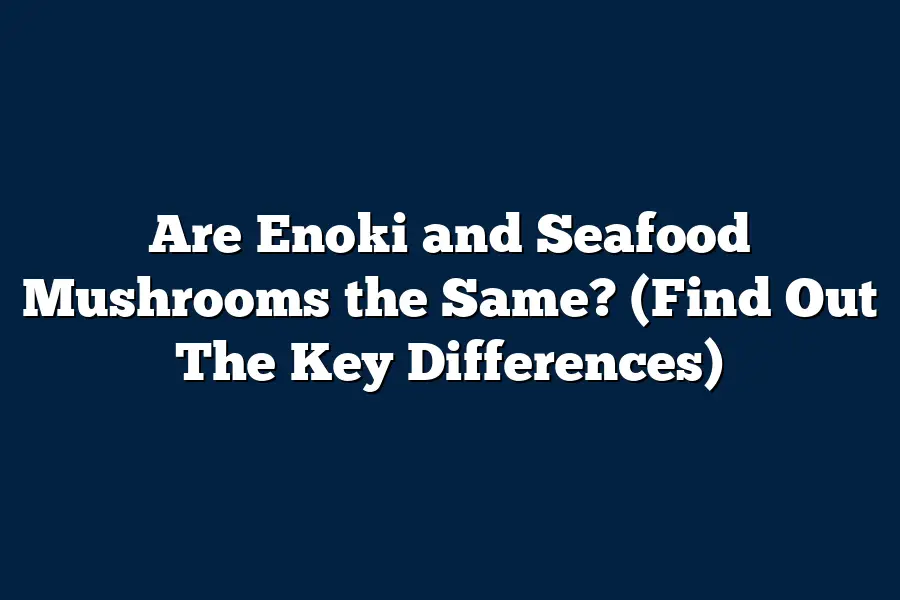Enoki mushrooms are different from seafood mushrooms. Enoki mushrooms are long and thin with small caps, while seafood mushrooms have a larger cap and a different texture. They also have distinct flavors that set them apart. When cooking, be sure to use the right type of mushroom based on your recipe to achieve the desired taste and texture.
Calling all foodies!
Are Enoki and Seafood mushrooms twins separated at birth?
Let’s uncover the mystery!
Join me as we compare these fungi side by side to help you pick the perfect mushroom for your next culinary creation.
Let’s dive in and discover the key differences between these versatile ingredients!
Table of Contents
Characteristics of Enoki Mushrooms: Appearance, Flavor, and Culinary Uses
When it comes to mushrooms, the variety available can be overwhelming.
Two types that are often confused are enoki mushrooms and seafood mushrooms.
In this section, we’ll dive into the unique characteristics of enoki mushrooms, focusing on their appearance, flavor, and culinary uses to help you differentiate them from seafood mushrooms.
Appearance of Enoki Mushrooms
Enoki mushrooms, scientifically known as Flammulina velutipes, are distinct in appearance compared to seafood mushrooms.
Here are some key visual characteristics to look out for:
- Long and Slender Stems: Enoki mushrooms have long, thin stems that can reach up to five inches in length.
- Small Caps: The caps of enoki mushrooms are small and delicate, resembling small buttons.
- White Color: These mushrooms are typically white or pale in color, adding a bright and elegant touch to dishes.
Flavor Profile of Enoki Mushrooms
In addition to their unique appearance, enoki mushrooms offer a delicate and mild flavor profile that complements various dishes.
Here’s what you can expect in terms of flavor:
- Mild and Sweet: Enoki mushrooms have a subtle, slightly sweet taste that pairs well with a wide range of ingredients.
- Crunchy Texture: When cooked, enoki mushrooms maintain a slightly crunchy texture, adding a pleasant contrast to dishes.
Culinary Uses of Enoki Mushrooms
Enoki mushrooms are versatile fungi that can elevate the flavor and presentation of many dishes.
Here are some popular culinary applications of enoki mushrooms:
- Soups and Broths: Enoki mushrooms are commonly added to soups and broths to provide a delicate flavor and aesthetic appeal.
- Stir-Fries: These mushrooms are excellent additions to stir-fries, offering a unique texture and flavor profile to the dish.
- Salads: Enoki mushrooms can be enjoyed raw in salads, adding a crisp texture and subtle umami flavor.
- Garnishes: Due to their elegant appearance, enoki mushrooms are often used as garnishes to enhance the visual appeal of various dishes.
understanding the appearance, flavor, and culinary uses of enoki mushrooms can help you distinguish them from seafood mushrooms and make informed decisions when incorporating them into your cooking.
Stay tuned for the next section where we’ll explore the characteristics of seafood mushrooms in further detail.
Characteristics of Enoki and Seafood Mushrooms: Appearance, Flavor, and Culinary Uses
When it comes to mushrooms, the world of culinary delights offers a diverse array of options, each with its own unique characteristics and flavors.
In this section, we will delve into the distinct features of Enoki mushrooms and seafood mushrooms, exploring their appearance, flavor profiles, and culinary applications.
Appearance:
Enoki mushrooms, also known as golden needle mushrooms, are easily recognizable by their slender, elongated stems and tiny, delicate caps.
These mushrooms typically grow in tight clusters, resembling a bundle of thin noodles or strands of spaghetti.
On the other hand, seafood mushrooms, such as oysters or shiitakes, showcase a broader cap with a meaty texture, varying in color from pale white to rich brown hues.
The visual disparity between Enoki and seafood mushrooms sets the stage for their unique culinary distinctions.
Flavor:
Enoki mushrooms are renowned for their mild, slightly fruity flavor and crunchy texture, adding a delightful crunch to dishes when consumed raw or a subtle sweetness when cooked.
In contrast, seafood mushrooms boast a more robust and earthy taste, often described as savory and umami-rich, providing depth and complexity to soups, stews, and stir-fries.
The diverse flavor profiles of these mushrooms offer chefs a versatile palette to elevate a wide range of culinary creations.
Culinary Uses:
Enoki mushrooms are prized in Asian cuisine for their delicate flavor and aesthetic appeal, commonly used in salads, soups, and hot pot dishes to impart a distinct crunch and visual contrast.
Seafood mushrooms, on the other hand, shine in hearty, umami-packed recipes, enhancing the depth of broths, sauces, and sautés with their bold taste and meaty texture.
Whether stir-fried with garlic and soy sauce or simmered in a savory broth, seafood mushrooms bring a rich umami essence to the dining table.
while Enoki and seafood mushrooms offer distinct appearances, flavors, and culinary applications, both varieties contribute unique characteristics to the culinary world, enriching dishes with their diverse profiles.
Experimenting with these mushrooms in your cooking endeavors can open doors to a world of creative culinary possibilities, tantalizing your taste buds with their distinctive qualities.
A Culinary Showdown: Contrasting the Key Differences Between Enoki and Seafood Mushrooms
In the world of mushrooms, two varieties that often cause confusion are enoki and seafood mushrooms.
While they may look somewhat similar at first glance, these two types of mushrooms have distinct differences in taste, texture, and culinary uses.
Let’s break down the key disparities between enoki and seafood mushrooms to help you distinguish between the two.
Visual Appearance
Enoki mushrooms, also known as golden needle mushrooms, are long and slender with small, rounded caps.
They have a crisp texture and a mild, slightly fruity flavor.
On the other hand, seafood mushrooms, also referred to as oyster mushrooms, boast a more substantial size with broad, fluted caps that resemble oyster shells.
Seafood mushrooms have a tender yet meaty texture and a savory umami taste.
Flavor Profile
Enoki mushrooms have a delicate taste that pairs well with various dishes, adding a subtle crunch and mild sweetness.
Their light flavor makes them versatile for use in salads, soups, stir-fries, and as garnishes.
Seafood mushrooms, on the other hand, offer a richer, earthier flavor reminiscent of seafood, hence their name.
They provide a savory depth to dishes and are popular in vegetarian and vegan recipes as a meat substitute due to their hearty taste.
Nutritional Value
In terms of nutritional content, enoki and seafood mushrooms offer different health benefits.
Enoki mushrooms are low in calories and rich in antioxidants, B-vitamins, and dietary fiber.
Seafood mushrooms, on the other hand, are a good source of protein, iron, potassium, and vitamin D.
Both varieties contain essential nutrients that contribute to a well-rounded diet, making them valuable additions to culinary creations.
Culinary Uses
Enoki mushrooms are commonly used in Asian cuisine, particularly Japanese dishes such as soups, hot pots, and noodle dishes.
Their delicate flavor and crunchy texture complement broths and light sauces, adding a refreshing element to the dish.
Seafood mushrooms, on the other hand, work well in a variety of recipes ranging from stir-fries and pasta dishes to grilled dishes and risottos.
Their robust flavor and meaty texture make them a versatile ingredient in both vegetarian and non-vegetarian cooking.
Cooking Methods
When it comes to cooking methods, enoki mushrooms are often eaten raw or added to dishes at the end of cooking to maintain their crisp texture.
Due to their delicate nature, enoki mushrooms are best suited for quick stir-fries, salads, and garnishes.
Seafood mushrooms, on the other hand, benefit from longer cooking times to develop their rich flavor and tender texture.
They can be sautéed, roasted, grilled, or braised to enhance their umami profile and bring out their inherent savory notes.
while enoki and seafood mushrooms may share similarities in appearance, their taste, texture, nutritional value, and culinary uses set them apart.
By understanding the unique characteristics of each mushroom variety, you can elevate your culinary creations and explore a world of diverse flavors in your cooking.
Stay tuned for more insights on mushrooms and culinary adventures!
Tips for Choosing the Right Mushroom for Your Dish
When it comes to selecting the perfect mushroom for your culinary creation, the choice can seem overwhelming.
From enoki to seafood mushrooms, each variety brings its own unique flavors and textures to the table.
To help you navigate this flavorful world of fungi, here are some essential tips to consider when choosing the right mushroom for your dish.
Consider the Flavor Profile
Mushrooms come in a wide range of flavors, from earthy and savory to nutty and sweet.
Understanding the flavor profile of different types of mushrooms can help you choose the right one to complement your dish.
For example, while enoki mushrooms have a mild, slightly fruity taste, seafood mushrooms offer a more robust umami flavor reminiscent of shellfish.
Textures Matter
In addition to flavor, the texture of mushrooms plays a crucial role in your dish.
Enoki mushrooms are delicate and tender, making them perfect for quick cooking methods like stir-frying or adding to soups.
On the other hand, seafood mushrooms have a meaty texture that holds up well in hearty dishes like stews or grilled skewers.
Cooking Methods
Different types of mushrooms respond differently to various cooking methods.
Enoki mushrooms are best enjoyed raw or lightly cooked to preserve their delicate texture and flavor.
Seafood mushrooms, on the other hand, benefit from longer cooking times to develop their rich umami taste and tenderize their meaty texture.
Pairing with Ingredients
When selecting mushrooms for your dish, consider how they will interact with other ingredients.
Enoki mushrooms’ subtle flavor makes them versatile and pairs well with a variety of ingredients, from vegetables to proteins.
Seafood mushrooms’ bold umami profile lends itself beautifully to seafood dishes, enhancing the overall savory notes of the meal.
Freshness is Key
No matter which mushroom you choose, freshness is essential for the best flavor and texture.
Look for mushrooms that are firm, with no slimy spots or discoloration.
Opt for locally sourced or organic varieties whenever possible to ensure the highest quality and flavor in your dishes.
By keeping these tips in mind, you can confidently select the perfect mushroom to elevate your next culinary creation.
Whether you opt for the delicate crunch of enoki mushrooms or the savory richness of seafood mushrooms, your dishes are sure to impress with the right selection of fungi.
Final Thoughts
While Enoki and Seafood mushrooms may look similar at first glance, their differences in flavor, texture, and culinary uses are what set them apart in the kitchen.
Remember, choosing the right mushroom can elevate your dish to a whole new level.
So next time you’re at the grocery store, pay attention to the type of mushroom you pick for that perfect stir-fry or salad.
Experiment with both Enoki and Seafood mushrooms to discover the unique tastes they bring to your cooking.
Happy mushroom hunting and bon appétit!

